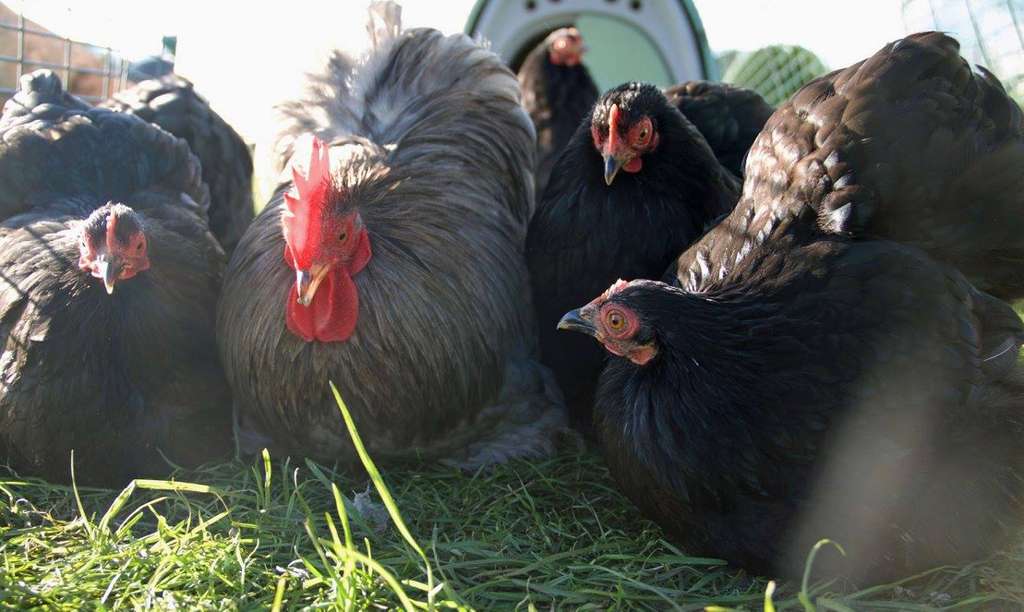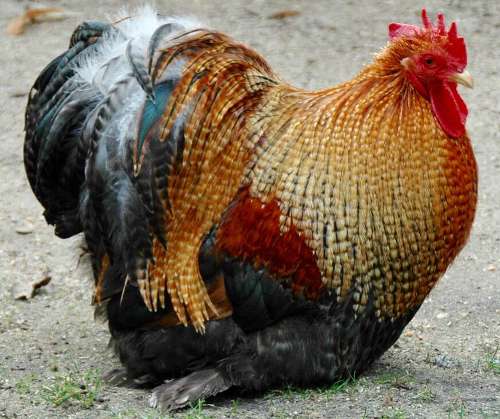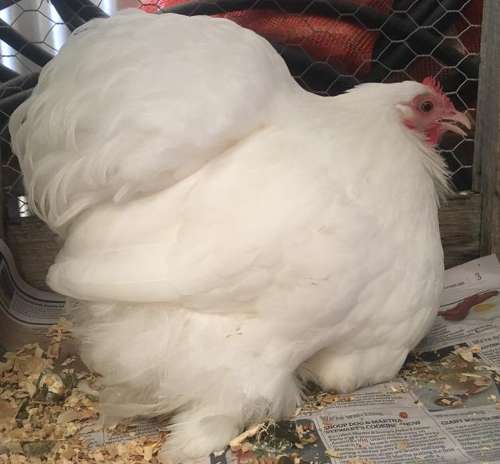Pekin breed standards and faults.

Pekin chicken breed standard:
Carriage: Bold, rather forward, the head to be lower than the tail giving necessary tilt.
In both sexes and all colours: Beak yellow, but in dark colours may be shaded with black or horn. Eyes red, orange or yellow-red preferred. Comb, face, wattles and ear-lobes bright red. Legs and feet yellow. (Dark legs permissible in blacks if the soles of the feet and back of shanks are yellow).
Type: Body short and broad. Back increasing in breadth to the saddle, which should be very full, rising well from between the shoulders and furnished with long soft feathers. Breast deep and full. Wings short, tightly tucked up, the ends hidden by the saddle hackle. Tail short and full, soft without hard quill feathers, the abundant couvert almost hiding tail feathers, the whole forming one unbroken duplex curve with the back and saddle. Tail should be carried higher than the head - i.e. tilt.
Head: Skull small and fine. Beak rather short, stout and slightly curved . Eyes large and bright.Eyes red, orange or yellow, red preferred. In both sexes: beak yellow but dark colours may be shaded with black or horn. Comb: single, small, firm, perfectly straight and erect, well serrated, curved from front to back. Face smooth and fine, preferably nearly as long as the wattles, which are long, ample, smooth and rounded.
Neck: Short, carried forward, with abundant long hackle reaching well down the back. Legs & Feet: Legs and feet yellow. Legs short and well apart. Stout thighs hidden by plentiful fluff. Hocks completely covered with soft feathers curling round the joints, (stiff feathers forming 'vulture hocks' are objectionable but not a disqualification.) Shanks short and thick, abundantly covered with soft, outstanding feathers. Toes four, string and straight, the middle and outer toes plentifully covered with soft feathers to their tips.
Plumage: Very abundant, long and wide, quite soft with very full fluff.
Female Pekin: The general characteristics are similar to those of the male, allowing for the natural sexual differences.
SUGGESTED WEIGHTS:
Male 24 - 28 oz (680 - 790 g.)
Female 20 - 24 oz (570 - 680 g.)
CLUB STANDARD:
Male not to exceed 24 oz
Female not to exceed 20 oz
Scale of points for Pekin Bantams:
Colour and markings - 15 points
Fluff and cushion - 15 points
Leg and foot feather - 10 points
Size and weight - 10 points
Type and carriage - 20 points
Head - 10 points
Length of shank - 10 points
Condition - 10 points
Total - 100 points.
Serious defects in Pekins:
Twisted or drooping comb. Slipped wings. Legs other than yellow (except for blacks). Eyes other than red, orange or yellow. Any deformity. Split front undesirable, but not a defect.
The Black: Male and female plumage: Rich sound black with lustrous beetle-green sheen throughout, free of white or coloured feathers (Note: some light under-colour in adult males is permissible as long as it does not show through).
The Blue: Male and female plumage: A rich pale blue (Pigeon blue preferred) free from lacing, but with rich dark blue hackles, back and tail in male.
The Buff: Male and female plumage: Sound buff, of a perfectly even shade throughout, quite sound to roots of feathers, and free from black, white or bronze feathers. The exact shade of buff is not material so long as it is level throughout and free from shaftiness, mealiness or lacing.
The Cuckoo: Male and female plumage: Evenly banded with dark slate on light French grey ground colour.
The Mottled: Male and female plumage: Evenly mottled with white at the tip of each feather on a rich black with beetle-green sheen.
The Barred: Male and female plumage: Each feather barred across with black bars, having a beetle-green sheen on a white background. The barring to be equal proportions of black and white. The colours to be sharply defined and not blurred or shaded off. Barring should continue through the shaft and into the under-fluff, and each feather must finish with a black tip. Plumage should present a bluish, steely appearance free from brassiness and of a uniform shade throughout.
The Columbian: Male and female plumage: Pearl-white with black markings. Head and neck white with dense black stripe down middle of each feather, free from black edgings or black tips. Saddle pearl-white. Tail feathers and tail converts glossy green-black, the coverts laced or not with white. Primaries black, or black edged with white; secondaries black on inner edge, white outer. Remainder of plumage entirely white, of pearl-grey shade, free from ticking. Under-colour either slate, blue-white or white.
The Lavender: Male and female plumage: The lavender is not a lighter shade of the blue Pekin. It is different genetically and is of a lighter more silver tint without the darker shade associated with the normal blue. The silver that is most obvious in the neck and saddle hackle feathers of the male.
The Partridge: Male plumage: Head dark orange-red, neck hackle bright orange or golden-red, becoming lighter towards the shoulders and preferably shading off as near lemon colour as possible, each feather distinctly striped down the middle with black, and free from shaftiness, black tipping or black fringe. Saddle hackle to resemble neck hackle as nearly as possible, Breast, thighs, underparts, tail, coverts, wing butts and foot feather, hock feather and fluff lustrous green-black, free from grey, rust or white. Back, shoulder coverts and wing bow rich crimson. Primaries black, free from white or grizzle, secondaries black inner web, bay outer, showing a distinct wing bay when closed.
Female plumage: Head and neck hackle light gold or straw, each feather distinctly striped down middle with black. Remainder clear light partridge brown, finely and evenly pencilled all over with concentric rings of dark shade (preferably glossy green-black). The whole of uniform shade and marking, and the ground colour of the soft brown shade frequently described as the colour of a dead oak leaf, with three concentric rings of pencilling or more over as much of the plumage as possible.
The White: Male and female plumage: Pure snow-white, free from cream or yellow tinge, or black splashes or peppering.
The Birchen: Male plumage: Hackle, back, saddle, shoulder coverts and wing bows silver white, the neck hackle with narrow black striping. Remainder rich black, the breast having a narrow silver margin around each feather, giving it a regular laced appearance gradually diminishing to perfect black thighs.
Female plumage: Hackle similar to that of the male. Remainder rich black, the breast very delicately laced as in the male.
The Silver Partridge: Male Plumage: Head silver-white, neck hackle silver-white, each feather distinctly striped with black and free from shaftiness, black tipping or black fringe. Saddle hackle to resemble neck hackle as nearly as possible. Breast, underparts, tail coverts, wing butts and foot feather, hock feather and fluff, lustrous green black, free from grey or white. Back, shoulder coverts and wing bow black. Primaries black, free from grizzle; Secondaries – black inner webb, white outer, showing a distinct wing bay when closed.
Female plumage: Head and neck silver white, each feather distinctly striped down the middle with black. Remainder silver grey, finely and evenly pencilled all over with concentric rings of dark shade, (preferably glossy green-black). The whole of uniform shade and markings with three concentric rings of pencilling or more, over as much of plumage as possible.
Colour standards:
Barred: Each feather barred across with black bands, having a beetle green sheen on a white background. The bands or barring to be of equal proportion - black and white. Barring should continue through the shaft and into the under fluff, each feather must finish with a black tip. Plumage should be presence in a bluish, steely appearance free from brassiness and of a uniform shade throughout. Legs and feet yellow, eyes red/orange.
Black: Rich sound black with lustrous beetle green sheen throughout, free from white or coloured feathers. Some light under colour in adult males is permissible so long as it does not show through. Dark legs are permissible if the soles of the feet and backs of shanks are yellow.
Blue: A rich, pale pigeon blue, free from lacing but with, dark blue hackles in the back and tail of the male.
Buff: Sound buff of a perfectly even shade throughout, quite sound to the roots of the feathers and free from black, white or bronze feathers. The exact shade of buff is not material so long as it is level throughout and free from shaftiness, mealiness or lacing.
Columbian: Pearl white with black markings. Head and neck hackle white with a dense black stripe down the middle of each feather, free from black edgings or black tips. Saddle pearl white. Tail feathers and tail couvert glossy green black, the couvert laced or not with white. Primaries black, or black edged with white. Secondaries black on inner edge, white outer. Remainder of plumage entirely white of pearl-grey shade, free from ticking. Under colour, either slate, blue-white or white.
Cuckoo: Evenly barred with dark slate on light French-grey ground.
Lavender: The lavender is not a lighter shade of the Blue Pekin. It is different genetically and is of a lighter more silver tint without the more darker shade associated with the blue. The silver tint is most obvious in the neck and saddle hackle feathers of the male. Beak yellow or horn. Eyes red, orange or yellow. Legs and toes deep yellow.
Mottled: Evenly mottled with white at the tip of each feather on a rich black with beetle green sheen.
Partridge: Head dark orange red, neck hackle bright orange or golden red, becoming lighter towards the shoulders and preferable shading off to as near lemon colour as possible, each feather distinctly striped down the middle with black, and free from shaftiness, black tipping or black fringe. Saddle hackle to resemble neck hackle as early as possible. Breast, thighs and under-parts, tail couvert, wing butts, foot feathers, hock feathers and fluff, a lustrous green-black, free from grey, rust or white. Back, shoulder couvert and wing bow, rich crimson. Primaries, black free from white or grizzle. Secondaries, black inner web, bay outer, showing a distinct wing bay when closed.
Female: Head and hackle light gold or straw, each feather distinctly striped down the middle with black. Remainder a clear light partridge brown, finely and evenly pencilled all over with concentric rings of dark shade (preferably glossy green black). The whole of the uniform shade, frequently described as the colour of a dead oak leaf, with three concentric rings of pencilling, or more over as much of the plumage as possible
White: Pure snow white, free from cream or yellow tinge, or black splashes or peppering. Comb, face and wattles and ear lobes, bright red.
I will now describe what I consider an ideal Pekin,and, for simplicity, give the shape and type first, which is the same in all the different varieties.
Starting at the head the comb should be single and finely serrated, and the smaller the comb the better. Eyes red, or nearly red, face red and smooth, lobes free from white, neck short and thick, chest broad and carried well forward, back short and broad, the shorter the better ; cushion full and nicely rounded, tail short and full, the feathers of the tail proper, twelve in number, being much softer in the quill than in any other breed of Bantam, and should be curved, not straight, as in other varieties. In addition, the cock's tail should be well furnished with side feathers corresponding in colour with the body.
The wings should be short, and tightly tucked up, legs short as possible, so that the body almost touches the ground ; the legs should be abundantly feathered right to the end of the middle toe without being "vulture hocked," which is a great defect in all Pekins.
The colour of legs in all the varieties of Pekin should be yellow, and the richer the yellow the better, although it is a difficult point to get in blacks. Willow or green legs should count heavily against the bird in the show pen. The one prevailing weakness in all Pekins is scaly leg, but this can be prevented by proper care and attention in keeping the houses and runs dry and clean. Where the birds are kept on nice dry sand scaly leg will rarely appear.
Pekin cockerels should rise from between his shoulders and not just forward of the tail proper, as is so often seen. The tail should be very full and surrounded with abundant saddle feathers and tail coverts with but few hard quills. The tail should help to add shape to both back and saddle. The fluff under the saddle and tail should be very full. This formation makes the most perfect and handsome looking bird.
Below: The natural tail formation for the male Pekin.

The legs of the Pekin should be short, in fact, a mature cock bird when well feathered, should appear as if his body almost touched the ground. To have this form his body must be set low between the legs, and the fluff must be quite abundant; this also widens out his legs and adds to their breadth.
Always remember, however, that a Pekin bantam never reaches its full form under sixteen or eighteen months, and is often two years old before it is fully developed. Quite often this is forgotten, and we expect to see a matured form on a young specimen.
A narrow or flat tail grows up between the wings, unsupported by any cushion, and gives the divided form of back, which is the very worst defect a Pekin bantam can have.
The cushion should begin just back of her shoulders and sweep back about the tail as in a well formed Cochin pullet of the larger variety. The Pekin tail being composed of flexible or soft feathers adds much to the beauty of a proper back and cushion.
Below: This picture shows the rear view of the proper formation. Broad, full and well feathered with good fluff almost to the ground.

This is a description of a fully developed hen. Do not hope for this just yet in a pullet. Let it be your aim to produce this form and feather, if possible, on a pullet, but feel satisfied when you have it in a moderate degree, for the female, like the male, continues to improve in form and feather each year, and never fully develops until the second year.
The combs of many of our Pekin bantams are much larger than their size and beauty demand.
For an in depth look in the colours and feather patterns of the Pekin bantam.
Conclusion:
The following points should be always remembered in breeding Pekin bantams: The neck should be short and full, neatly arched; the body should lean slightly forward, and the top of the tail be as high as the top of the head on the male. The head should not be held high above the body on a long, slim neck overlooking a slim, flat tail; all these points must be considered in the producing of a perfect Pekin.
